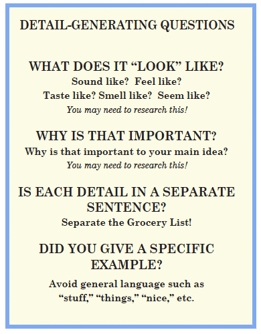Recommended Reading | Writing Across the Curriculum
Integrating Writing Skills with Social Studies: Supporting the Standards
Dates, people, and events - oh my! Social Studies is often either an incredibly interesting subject area that creates deeper insight and understanding of our past or an overwhelming amount of facts and dates for students to learn and remember. For many students, engagement with the content and retention of its detail may suffer in part due to a lack of reinforcement of writing techniques and applications. The critical eye of an author (author’s eyes) not only makes Social Studies texts more accessible, but helps students to think critically and recall or share important information about a particular topic.
How does this work? Just take a look at a few standards:
Identify Texas’ role in the Mexican War of Independence and the war’s impact on the development of Texas
Explain the growth, development, and impact of the cattle industry such as contributions made by Charles Goodnight, Richard King, and Lizzie Johnson
Summarize motivations for European exploration and settlement of Texas, including economic opportunity, competition, and the desire for expansion
Identify and compare the ways of life of American Indian groups in Texas before European explorations such as the Lipan Apache, Karankawa, Caddo, and Jumano
Notice the verbs - identify, explain, summarize, compare…Clearly, critical thinking skills must be at work! Let’s attach each of these to a few of the Empowering Writers techniques and applications that will make this content an easier lift.
1. Identify
What do students need to know to address this task successfully?
Students need to understand:
1.) organization and structure of text
2.) how to read the prompt for what is required and what choices need to be made
3.) how to read text with an author’s eye through the process of annotation and analysis
How do they learn and apply those skills?
EW Lessons: Introducing Graphic Organizers, Strategic Reading - Informed Writing, Annotating & Analyzing Informational Texts
Using the Informational Pillar increases understanding of the structure of the text - where an author introduces the topic and the main ideas that will be explained in detail. Students will start by identifying the givens (what they have to focus on or write about) and the variables (choices they can make when selecting details to support the response) of the question or task. By using text features and through the steps of annotation and analysis, students will label specific blurbs that will direct them to both givens- the role Texas had and the impact of the war. This scaffolded way of reading and responding strategically builds confidence in answering effectively.
2. Explain

What do students need to know to address this task successfully?
Students need to understand:
1.) how to identify specific evidence for a clear understanding of the content
2.) how to use the questions - What does it look like? and Why is it important? - to expand detail
3.) the use of sentence starters and transitional language for sentence variety and fluidity in the explanation
How do they learn and apply those skills?
EW Lessons: What Does It Look Like? Why is it Important?, Using Detail-Generating Questions, Writing a Paragraph Using Supporting Details
What does growth and development look like in the cattle industry? Why was that important to the cattle industry? What does the impact of the cattle industry look like? Why was that important to the cattle industry? Using the detail-generating questions - What does it look like? and Why is it important? provide a surefire way for students to explain their thinking with depth. Whether a source text or form of media, noting or listening for the answers to these detail-generating questions can be just the tool students need to go beyond the surface in their understanding and responses.
3. Summarize

What do students need to know to address this task successfully?
Students need to understand:
1.) a consistent way of summarizing information with the topic and main ideas
2.) how to use informative verbs to expand the summary to sentence form
How do they learn and apply those skills?
EW Lessons: Summarizing in Paragraph Form, Reading and Summarizing Texts
Want a quick way to recall important information about European exploration and settlement in Texas? Use the summarizing framework, taken straight from the Informational Pillar! What are the topic and main ideas? Pair this with informative verbs like recognize, discover, or explore, and students will find a tried and true way to pull together key points about the motivations of economic opportunity, competition, and the desire for expansion.
4. Compare

What do students need to know to address this task successfully?
Students need to understand:
1.) the steps to approach response to text
2.) how to use a grid to organize the information
3.) techniques and sentence starters for paraphrasing and citing
How do they learn and apply those skills? 
EW Lessons: Preparing to Respond in Writing to Multiple Texts, Comparing and Contrasting in Research Simulation Tasks, Paraphrasing, Giving the Author Credit
Comparison is indeed a high level skill requiring students to collect commonalities, in this case, across different groups of people. Using a comparison grid can keep bulleted information organized so that it can be easily referenced for quick recall or more fully explained when written into sentences with citing and paraphrasing techniques.
By utilizing the same Empowering Writers tools and skills that students already use in their Reading Language Arts class, Social Studies content becomes more easily accessible and, in turn, more engaging! To provide more structure for processing and comprehending Social Studies content, try our Write About Social Studies resource.